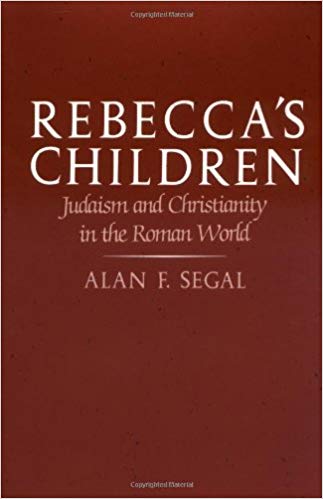File:1986 * Segal.jpg
1986_*_Segal.jpg (323 × 499 pixels, file size: 19 KB, MIME type: image/jpeg)
{en} Alan F. Segal, Rebecca's Children: Judaism and Christianity in the Roman World (Cambridge, MA: Harvard University Press, 1986).
Abstract
"Renowned scholar Alan Segal offers startlingly new insights into the origins of rabbinic Judaism and Christianity. These twin descendants of Hebrew heritage shared the same social, cultural, and ideological context, as well as the same minority status, in the first century of the common era.Through skillful application of social science theories to ancient Western thought, including Judaism, Hellenism, early Christianity, and a host of other sectarian beliefs, Segal reinterprets some of the most important events of Jewish and Christian life in the Roman world. For example, he finds: --That the concept of myth, as it related to covenant, was a central force of Jewish life. The Torah was the embodiment of covenant both for Jews living in exile and for the Jewish community in Israel. --That the Torah legitimated all native institutions at the time of Jesus, even though the Temple, Sanhedrin, and Synagogue, as well as the concepts of messiah and resurrection, were profoundly affected by Hellenism. Both rabbinic Judaism and Christianity necessarily relied on the Torah to authenticate their claim on Jewish life. --That the unique cohesion of early Christianity, assuring its phenomenal success in the Hellenistic world, was assisted by the Jewish practices of apocalypticism, conversion, and rejection of civic ritual. --That the concept of acculturation clarifies the Maccabean revolt, the rise of Christianity, and the emergence of rabbinic Judaism.--That contemporary models of revolution point to the place of Jesus as a radical.--That early rabbinism grew out of the attempts of middle-class Pharisees to reach a higher sacred status in Judea while at the same time maintaining their cohesion through ritual purity. --That the dispute between Judaism and Christianity reflects a class conflict over the meaning of covenant. The rising turmoil between Jews and Christians affected the development of both rabbinic Judaism and Christianity, as each tried to preserve the partly destroyed culture of Judea by becoming a religion. Both attempted to take the best of Judean and Hellenistic society without giving up the essential aspects of Israelite life. Both spiritualized old national symbols of the covenant and practices that consolidated power after the disastrous wars with Rome. The separation between Judaism and Christianity, sealed in magic, monotheism, law, and universalism, fractured what remained of the shared symbolic life of Judea, leaving Judaism and Christianity to fulfill the biblical demands of their god in entirely different ways."--Publisher description.
"Using the biblical metaphor of the struggle of Rebecca’s twin children—Jacob and Esau—in the womb, Segal argues that the time of Jesus marks the beginning of not just one, but two religions: Judaism and Christianity. In the first half of the book, Segal sets the stage for this argument by first identifying “covenant” as Israel’s root metaphor (chapter 1), 2) then describing the diverse Jewish society that existed during Jesus’ day (chapter 2), and finally envisioning Jesus as the leader of an apocalyptic sectarian movement within Judaism. The later half of the book shows how the division between the religions occurred. Segal first contrasts the importance of Paul’s conversion for later Christianity (chapter four) with Rabbinic Judaism’s attention to ritual purity and personal piety (chapter five) to show how both Christianity and Rabbinic Judaism reflected an evolutionary step forward in religion in the midst of a complex and changing world. In the final two chapters, Segal underscores the parting of the ways between the religions, by highlighting the suspicious attitudes both religions had to one another (chapter six) and then contrasting the divergent theologies, which each religion developed to substantiate its claim to existence (chapter seven). Segal’s work should be commended for its innovative perspective on the relationship between the two religions. For Segal, like Neusner, though Judaism and Christianity were like “twins in Rebecca’s womb,” it is difficult to know which one is older than the other. The two religions grew, developed, and matured in relationship to one another. "-–Deborah Forger, University of Michigan
Editions
Published in Cambridge, MA: Harvard University Press, 1986.
Contents
- I. Israel between empires
- II. Society in the time of Jesus
- III. Jesus, the Jewish revolutionary
- IV. Paul, the convert and apostle
- V. Origins of the rabbinic movement
- VI. Communities in conflict
- VII. The ways divide.
External links
File history
Click on a date/time to view the file as it appeared at that time.
| Date/Time | Thumbnail | Dimensions | User | Comment | |
|---|---|---|---|---|---|
| current | 00:36, 29 July 2018 |  | 323 × 499 (19 KB) | Gabriele Boccaccini (talk | contribs) |
You cannot overwrite this file.
File usage
The following 3 pages use this file:
- 1986
- Jewish Authorship--1980s
- Jewish Authorship--English
- English language--1980s
- Harvard University Press
- Second Temple Studies--1980s
- Second Temple Studies--English
- Early Christian Studies--1980s
- Early Christian Studies--English
- Early Jewish Studies--1980s
- Early Jewish Studies--English
- Rabbinic Origins (subject)
- Roman Period (subject)
- Christian & Rabbinic Origins (subject)
- Parting of the Ways (subject)
- Top 1980s
- 1980s
- Second Temple Studies
- Super Bestsellers
